Comprehensive Report: Communication Protocols, Devices, and Networks
VerifiedAdded on 2023/01/16
|9
|1907
|76
Report
AI Summary
This report provides a comprehensive overview of communication networks, protocols, and devices. It begins by identifying various communication protocols like Bluetooth and TCP/IP, and then delves into the 802.11 standards and the OSI model, explaining each layer's function with examples...

COMMUNICATION AND INFORMATION TECHNOLOGY
Name
Course
Date
Name
Course
Date
Paraphrase This Document
Need a fresh take? Get an instant paraphrase of this document with our AI Paraphraser
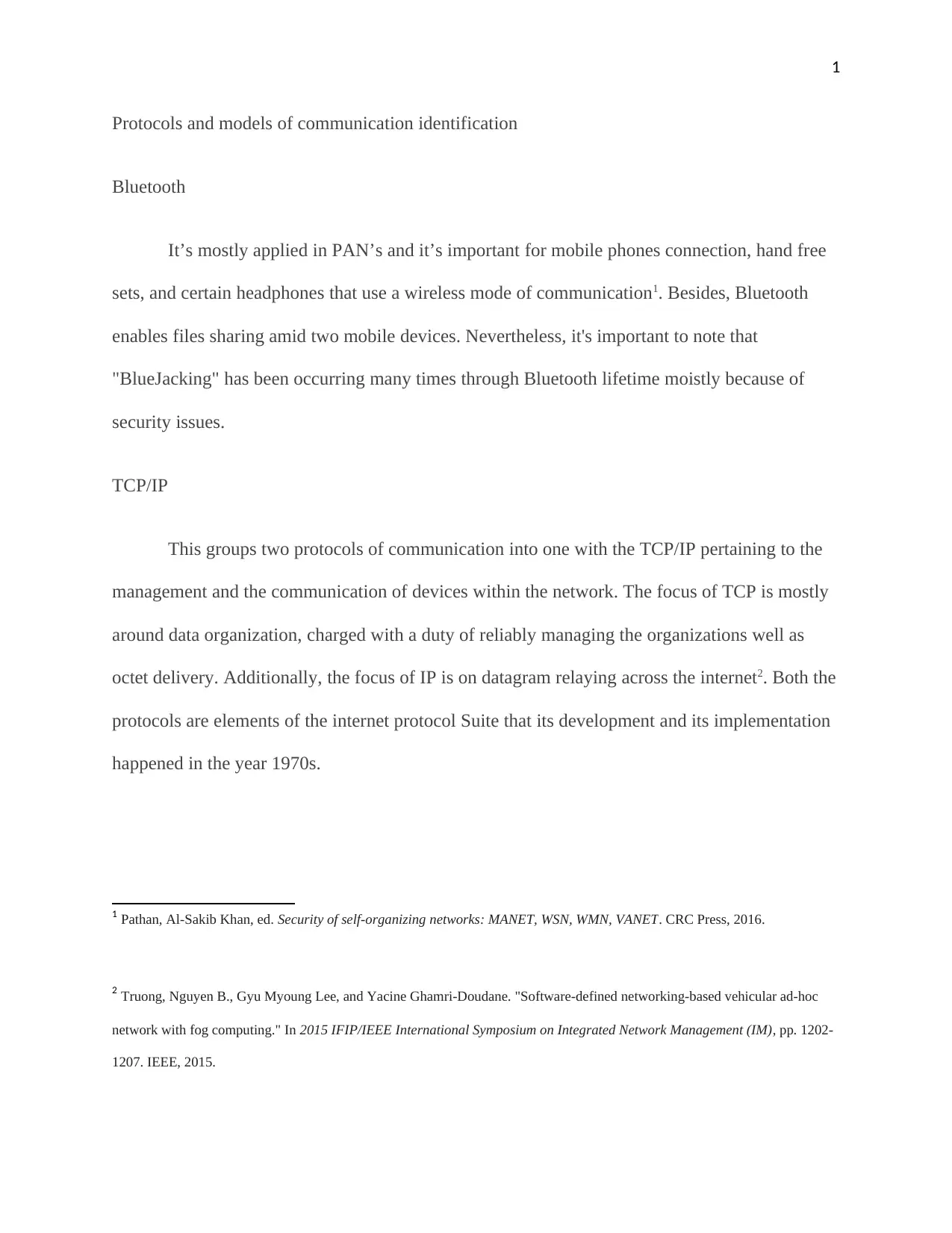
1
Protocols and models of communication identification
Bluetooth
It’s mostly applied in PAN’s and it’s important for mobile phones connection, hand free
sets, and certain headphones that use a wireless mode of communication1. Besides, Bluetooth
enables files sharing amid two mobile devices. Nevertheless, it's important to note that
"BlueJacking" has been occurring many times through Bluetooth lifetime moistly because of
security issues.
TCP/IP
This groups two protocols of communication into one with the TCP/IP pertaining to the
management and the communication of devices within the network. The focus of TCP is mostly
around data organization, charged with a duty of reliably managing the organizations well as
octet delivery. Additionally, the focus of IP is on datagram relaying across the internet2. Both the
protocols are elements of the internet protocol Suite that its development and its implementation
happened in the year 1970s.
1 Pathan, Al-Sakib Khan, ed. Security of self-organizing networks: MANET, WSN, WMN, VANET. CRC Press, 2016.
2 Truong, Nguyen B., Gyu Myoung Lee, and Yacine Ghamri-Doudane. "Software-defined networking-based vehicular ad-hoc
network with fog computing." In 2015 IFIP/IEEE International Symposium on Integrated Network Management (IM), pp. 1202-
1207. IEEE, 2015.
Protocols and models of communication identification
Bluetooth
It’s mostly applied in PAN’s and it’s important for mobile phones connection, hand free
sets, and certain headphones that use a wireless mode of communication1. Besides, Bluetooth
enables files sharing amid two mobile devices. Nevertheless, it's important to note that
"BlueJacking" has been occurring many times through Bluetooth lifetime moistly because of
security issues.
TCP/IP
This groups two protocols of communication into one with the TCP/IP pertaining to the
management and the communication of devices within the network. The focus of TCP is mostly
around data organization, charged with a duty of reliably managing the organizations well as
octet delivery. Additionally, the focus of IP is on datagram relaying across the internet2. Both the
protocols are elements of the internet protocol Suite that its development and its implementation
happened in the year 1970s.
1 Pathan, Al-Sakib Khan, ed. Security of self-organizing networks: MANET, WSN, WMN, VANET. CRC Press, 2016.
2 Truong, Nguyen B., Gyu Myoung Lee, and Yacine Ghamri-Doudane. "Software-defined networking-based vehicular ad-hoc
network with fog computing." In 2015 IFIP/IEEE International Symposium on Integrated Network Management (IM), pp. 1202-
1207. IEEE, 2015.
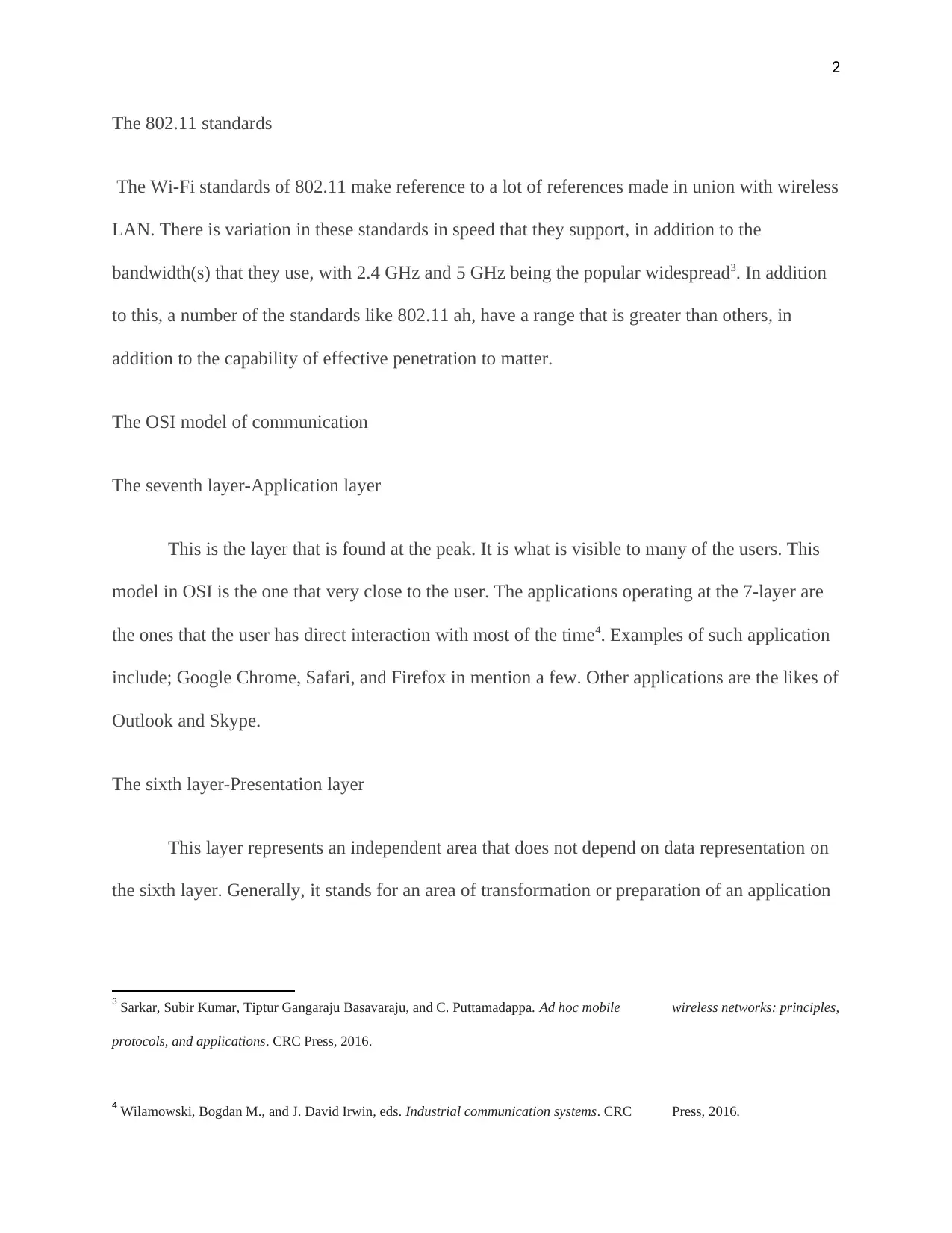
2
The 802.11 standards
The Wi-Fi standards of 802.11 make reference to a lot of references made in union with wireless
LAN. There is variation in these standards in speed that they support, in addition to the
bandwidth(s) that they use, with 2.4 GHz and 5 GHz being the popular widespread3. In addition
to this, a number of the standards like 802.11 ah, have a range that is greater than others, in
addition to the capability of effective penetration to matter.
The OSI model of communication
The seventh layer-Application layer
This is the layer that is found at the peak. It is what is visible to many of the users. This
model in OSI is the one that very close to the user. The applications operating at the 7-layer are
the ones that the user has direct interaction with most of the time4. Examples of such application
include; Google Chrome, Safari, and Firefox in mention a few. Other applications are the likes of
Outlook and Skype.
The sixth layer-Presentation layer
This layer represents an independent area that does not depend on data representation on
the sixth layer. Generally, it stands for an area of transformation or preparation of an application
3 Sarkar, Subir Kumar, Tiptur Gangaraju Basavaraju, and C. Puttamadappa. Ad hoc mobile wireless networks: principles,
protocols, and applications. CRC Press, 2016.
4 Wilamowski, Bogdan M., and J. David Irwin, eds. Industrial communication systems. CRC Press, 2016.
The 802.11 standards
The Wi-Fi standards of 802.11 make reference to a lot of references made in union with wireless
LAN. There is variation in these standards in speed that they support, in addition to the
bandwidth(s) that they use, with 2.4 GHz and 5 GHz being the popular widespread3. In addition
to this, a number of the standards like 802.11 ah, have a range that is greater than others, in
addition to the capability of effective penetration to matter.
The OSI model of communication
The seventh layer-Application layer
This is the layer that is found at the peak. It is what is visible to many of the users. This
model in OSI is the one that very close to the user. The applications operating at the 7-layer are
the ones that the user has direct interaction with most of the time4. Examples of such application
include; Google Chrome, Safari, and Firefox in mention a few. Other applications are the likes of
Outlook and Skype.
The sixth layer-Presentation layer
This layer represents an independent area that does not depend on data representation on
the sixth layer. Generally, it stands for an area of transformation or preparation of an application
3 Sarkar, Subir Kumar, Tiptur Gangaraju Basavaraju, and C. Puttamadappa. Ad hoc mobile wireless networks: principles,
protocols, and applications. CRC Press, 2016.
4 Wilamowski, Bogdan M., and J. David Irwin, eds. Industrial communication systems. CRC Press, 2016.
⊘ This is a preview!⊘
Do you want full access?
Subscribe today to unlock all pages.

Trusted by 1+ million students worldwide
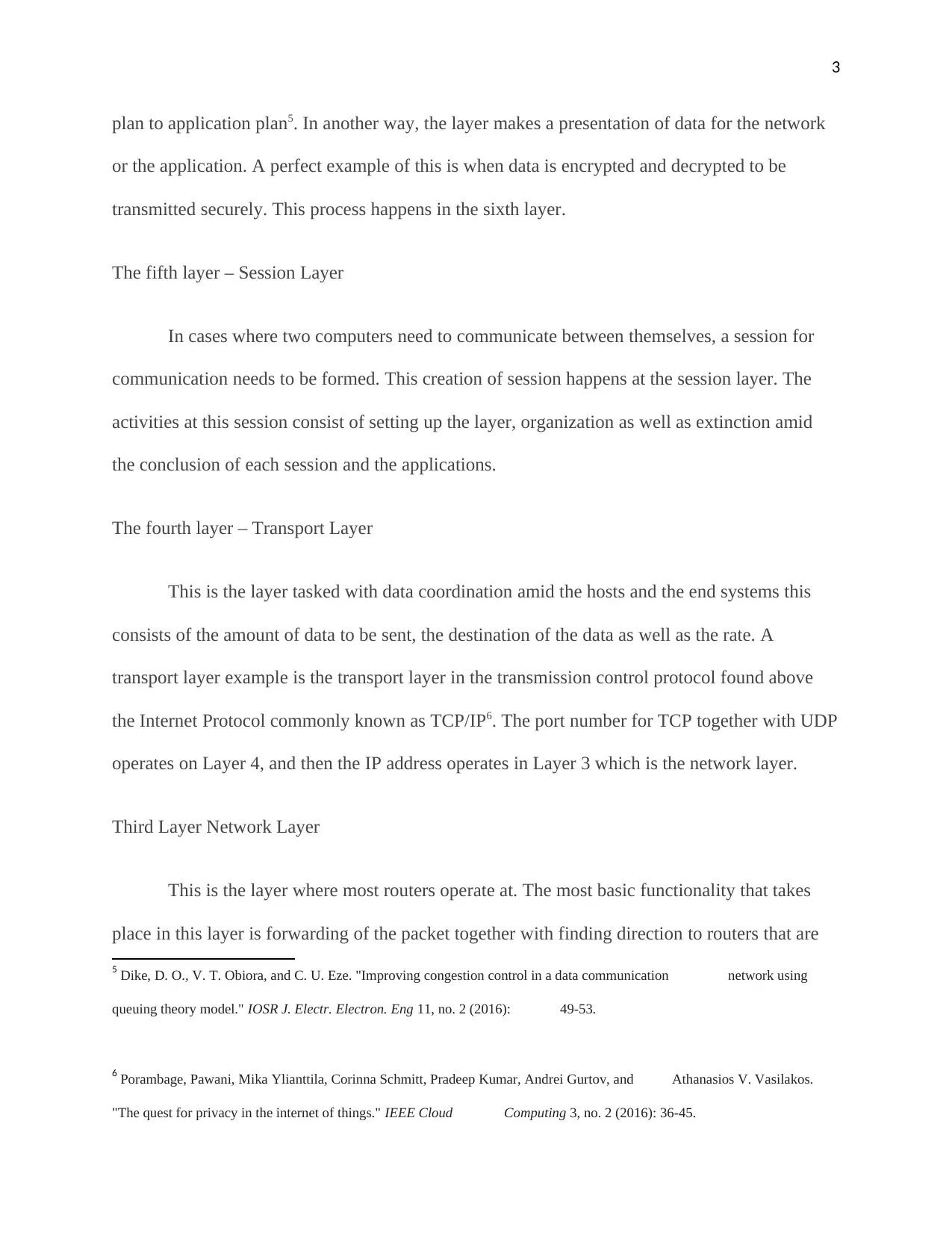
3
plan to application plan5. In another way, the layer makes a presentation of data for the network
or the application. A perfect example of this is when data is encrypted and decrypted to be
transmitted securely. This process happens in the sixth layer.
The fifth layer – Session Layer
In cases where two computers need to communicate between themselves, a session for
communication needs to be formed. This creation of session happens at the session layer. The
activities at this session consist of setting up the layer, organization as well as extinction amid
the conclusion of each session and the applications.
The fourth layer – Transport Layer
This is the layer tasked with data coordination amid the hosts and the end systems this
consists of the amount of data to be sent, the destination of the data as well as the rate. A
transport layer example is the transport layer in the transmission control protocol found above
the Internet Protocol commonly known as TCP/IP6. The port number for TCP together with UDP
operates on Layer 4, and then the IP address operates in Layer 3 which is the network layer.
Third Layer Network Layer
This is the layer where most routers operate at. The most basic functionality that takes
place in this layer is forwarding of the packet together with finding direction to routers that are
5 Dike, D. O., V. T. Obiora, and C. U. Eze. "Improving congestion control in a data communication network using
queuing theory model." IOSR J. Electr. Electron. Eng 11, no. 2 (2016): 49-53.
6 Porambage, Pawani, Mika Ylianttila, Corinna Schmitt, Pradeep Kumar, Andrei Gurtov, and Athanasios V. Vasilakos.
"The quest for privacy in the internet of things." IEEE Cloud Computing 3, no. 2 (2016): 36-45.
plan to application plan5. In another way, the layer makes a presentation of data for the network
or the application. A perfect example of this is when data is encrypted and decrypted to be
transmitted securely. This process happens in the sixth layer.
The fifth layer – Session Layer
In cases where two computers need to communicate between themselves, a session for
communication needs to be formed. This creation of session happens at the session layer. The
activities at this session consist of setting up the layer, organization as well as extinction amid
the conclusion of each session and the applications.
The fourth layer – Transport Layer
This is the layer tasked with data coordination amid the hosts and the end systems this
consists of the amount of data to be sent, the destination of the data as well as the rate. A
transport layer example is the transport layer in the transmission control protocol found above
the Internet Protocol commonly known as TCP/IP6. The port number for TCP together with UDP
operates on Layer 4, and then the IP address operates in Layer 3 which is the network layer.
Third Layer Network Layer
This is the layer where most routers operate at. The most basic functionality that takes
place in this layer is forwarding of the packet together with finding direction to routers that are
5 Dike, D. O., V. T. Obiora, and C. U. Eze. "Improving congestion control in a data communication network using
queuing theory model." IOSR J. Electr. Electron. Eng 11, no. 2 (2016): 49-53.
6 Porambage, Pawani, Mika Ylianttila, Corinna Schmitt, Pradeep Kumar, Andrei Gurtov, and Athanasios V. Vasilakos.
"The quest for privacy in the internet of things." IEEE Cloud Computing 3, no. 2 (2016): 36-45.
Paraphrase This Document
Need a fresh take? Get an instant paraphrase of this document with our AI Paraphraser
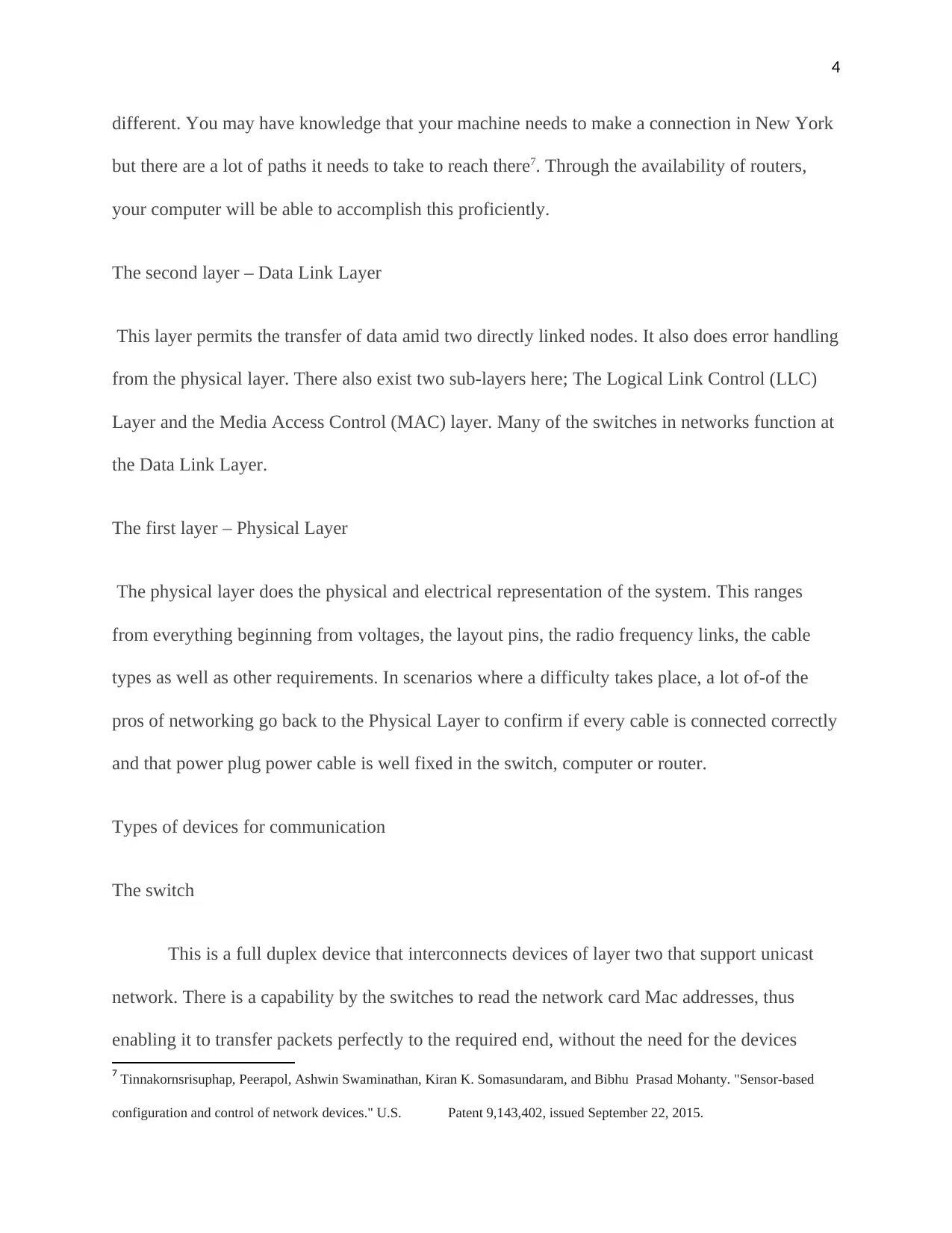
4
different. You may have knowledge that your machine needs to make a connection in New York
but there are a lot of paths it needs to take to reach there7. Through the availability of routers,
your computer will be able to accomplish this proficiently.
The second layer – Data Link Layer
This layer permits the transfer of data amid two directly linked nodes. It also does error handling
from the physical layer. There also exist two sub-layers here; The Logical Link Control (LLC)
Layer and the Media Access Control (MAC) layer. Many of the switches in networks function at
the Data Link Layer.
The first layer – Physical Layer
The physical layer does the physical and electrical representation of the system. This ranges
from everything beginning from voltages, the layout pins, the radio frequency links, the cable
types as well as other requirements. In scenarios where a difficulty takes place, a lot of-of the
pros of networking go back to the Physical Layer to confirm if every cable is connected correctly
and that power plug power cable is well fixed in the switch, computer or router.
Types of devices for communication
The switch
This is a full duplex device that interconnects devices of layer two that support unicast
network. There is a capability by the switches to read the network card Mac addresses, thus
enabling it to transfer packets perfectly to the required end, without the need for the devices
7 Tinnakornsrisuphap, Peerapol, Ashwin Swaminathan, Kiran K. Somasundaram, and Bibhu Prasad Mohanty. "Sensor-based
configuration and control of network devices." U.S. Patent 9,143,402, issued September 22, 2015.
different. You may have knowledge that your machine needs to make a connection in New York
but there are a lot of paths it needs to take to reach there7. Through the availability of routers,
your computer will be able to accomplish this proficiently.
The second layer – Data Link Layer
This layer permits the transfer of data amid two directly linked nodes. It also does error handling
from the physical layer. There also exist two sub-layers here; The Logical Link Control (LLC)
Layer and the Media Access Control (MAC) layer. Many of the switches in networks function at
the Data Link Layer.
The first layer – Physical Layer
The physical layer does the physical and electrical representation of the system. This ranges
from everything beginning from voltages, the layout pins, the radio frequency links, the cable
types as well as other requirements. In scenarios where a difficulty takes place, a lot of-of the
pros of networking go back to the Physical Layer to confirm if every cable is connected correctly
and that power plug power cable is well fixed in the switch, computer or router.
Types of devices for communication
The switch
This is a full duplex device that interconnects devices of layer two that support unicast
network. There is a capability by the switches to read the network card Mac addresses, thus
enabling it to transfer packets perfectly to the required end, without the need for the devices
7 Tinnakornsrisuphap, Peerapol, Ashwin Swaminathan, Kiran K. Somasundaram, and Bibhu Prasad Mohanty. "Sensor-based
configuration and control of network devices." U.S. Patent 9,143,402, issued September 22, 2015.
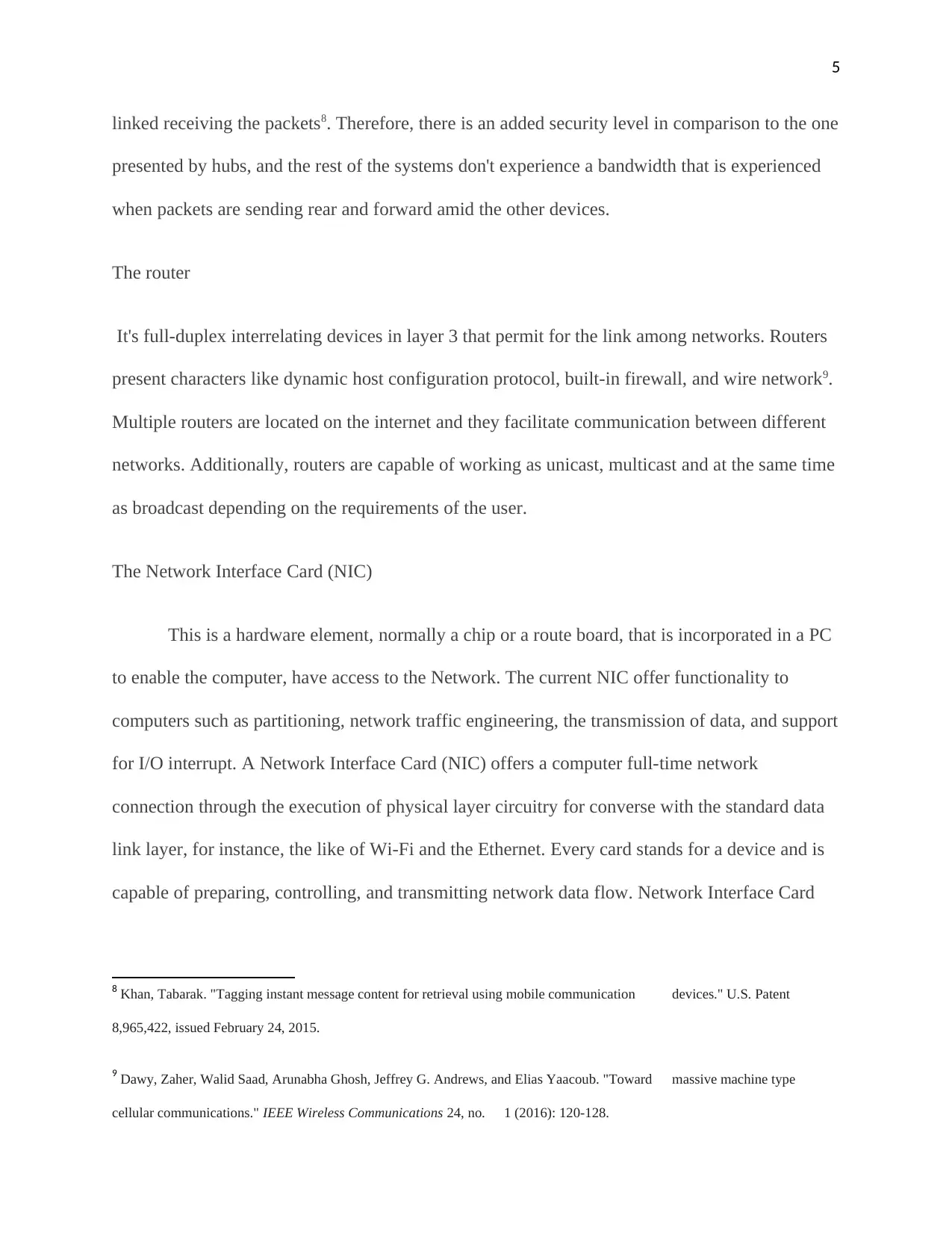
5
linked receiving the packets8. Therefore, there is an added security level in comparison to the one
presented by hubs, and the rest of the systems don't experience a bandwidth that is experienced
when packets are sending rear and forward amid the other devices.
The router
It's full-duplex interrelating devices in layer 3 that permit for the link among networks. Routers
present characters like dynamic host configuration protocol, built-in firewall, and wire network9.
Multiple routers are located on the internet and they facilitate communication between different
networks. Additionally, routers are capable of working as unicast, multicast and at the same time
as broadcast depending on the requirements of the user.
The Network Interface Card (NIC)
This is a hardware element, normally a chip or a route board, that is incorporated in a PC
to enable the computer, have access to the Network. The current NIC offer functionality to
computers such as partitioning, network traffic engineering, the transmission of data, and support
for I/O interrupt. A Network Interface Card (NIC) offers a computer full-time network
connection through the execution of physical layer circuitry for converse with the standard data
link layer, for instance, the like of Wi-Fi and the Ethernet. Every card stands for a device and is
capable of preparing, controlling, and transmitting network data flow. Network Interface Card
8 Khan, Tabarak. "Tagging instant message content for retrieval using mobile communication devices." U.S. Patent
8,965,422, issued February 24, 2015.
9 Dawy, Zaher, Walid Saad, Arunabha Ghosh, Jeffrey G. Andrews, and Elias Yaacoub. "Toward massive machine type
cellular communications." IEEE Wireless Communications 24, no. 1 (2016): 120-128.
linked receiving the packets8. Therefore, there is an added security level in comparison to the one
presented by hubs, and the rest of the systems don't experience a bandwidth that is experienced
when packets are sending rear and forward amid the other devices.
The router
It's full-duplex interrelating devices in layer 3 that permit for the link among networks. Routers
present characters like dynamic host configuration protocol, built-in firewall, and wire network9.
Multiple routers are located on the internet and they facilitate communication between different
networks. Additionally, routers are capable of working as unicast, multicast and at the same time
as broadcast depending on the requirements of the user.
The Network Interface Card (NIC)
This is a hardware element, normally a chip or a route board, that is incorporated in a PC
to enable the computer, have access to the Network. The current NIC offer functionality to
computers such as partitioning, network traffic engineering, the transmission of data, and support
for I/O interrupt. A Network Interface Card (NIC) offers a computer full-time network
connection through the execution of physical layer circuitry for converse with the standard data
link layer, for instance, the like of Wi-Fi and the Ethernet. Every card stands for a device and is
capable of preparing, controlling, and transmitting network data flow. Network Interface Card
8 Khan, Tabarak. "Tagging instant message content for retrieval using mobile communication devices." U.S. Patent
8,965,422, issued February 24, 2015.
9 Dawy, Zaher, Walid Saad, Arunabha Ghosh, Jeffrey G. Andrews, and Elias Yaacoub. "Toward massive machine type
cellular communications." IEEE Wireless Communications 24, no. 1 (2016): 120-128.
⊘ This is a preview!⊘
Do you want full access?
Subscribe today to unlock all pages.

Trusted by 1+ million students worldwide

6
makes the use of OSI model when sending signals to the physical layer, work as an interface at
the network layer, and transmitting packets of data at the TCP/IP10.
Bibliography
10 Mckee, Martin W., Paul T. Schultz, and Robert A. Sartini. "Weighting social network relationships based on communications
history." U.S. Patent 9,400,972, issued July 26, 2016.
makes the use of OSI model when sending signals to the physical layer, work as an interface at
the network layer, and transmitting packets of data at the TCP/IP10.
Bibliography
10 Mckee, Martin W., Paul T. Schultz, and Robert A. Sartini. "Weighting social network relationships based on communications
history." U.S. Patent 9,400,972, issued July 26, 2016.
Paraphrase This Document
Need a fresh take? Get an instant paraphrase of this document with our AI Paraphraser
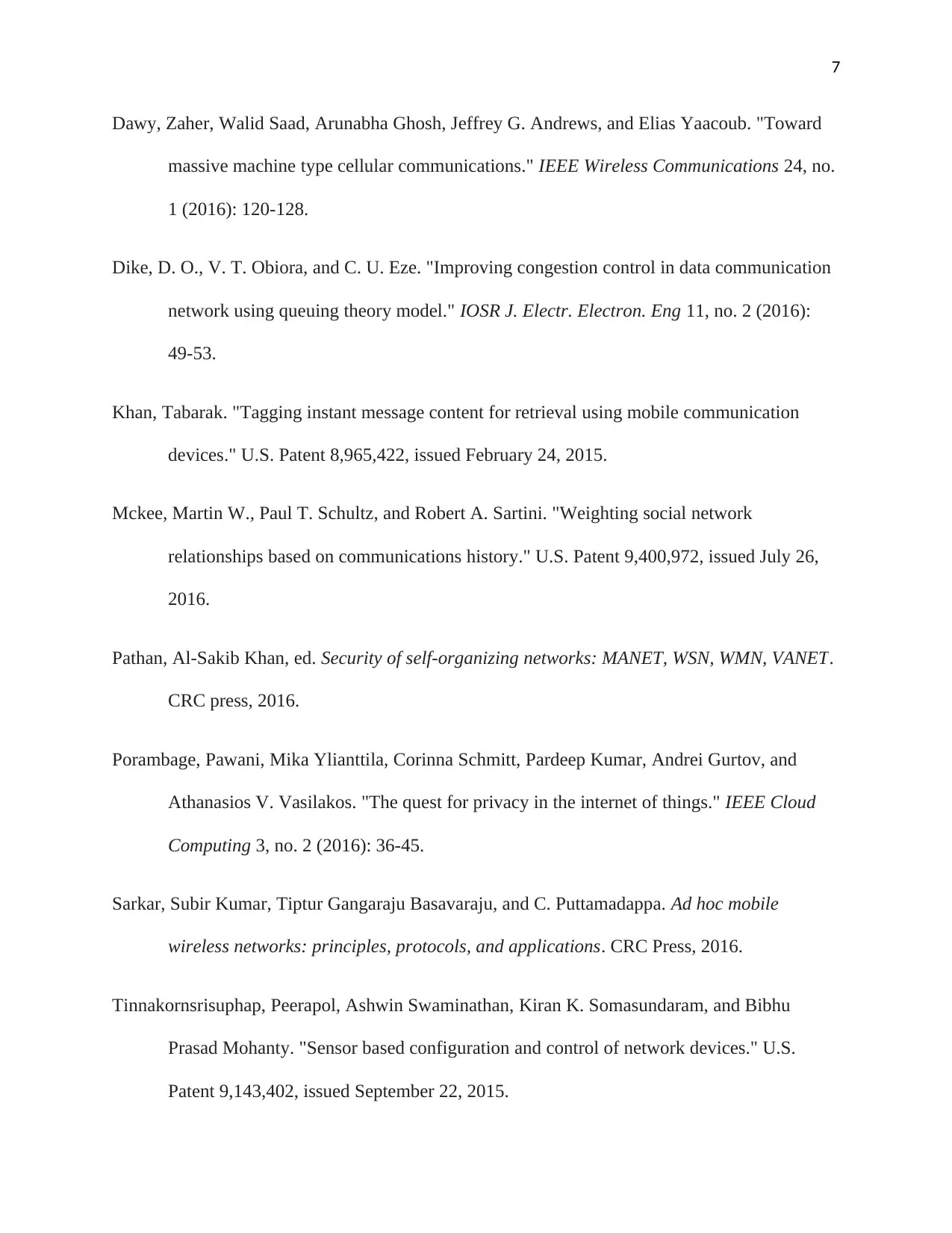
7
Dawy, Zaher, Walid Saad, Arunabha Ghosh, Jeffrey G. Andrews, and Elias Yaacoub. "Toward
massive machine type cellular communications." IEEE Wireless Communications 24, no.
1 (2016): 120-128.
Dike, D. O., V. T. Obiora, and C. U. Eze. "Improving congestion control in data communication
network using queuing theory model." IOSR J. Electr. Electron. Eng 11, no. 2 (2016):
49-53.
Khan, Tabarak. "Tagging instant message content for retrieval using mobile communication
devices." U.S. Patent 8,965,422, issued February 24, 2015.
Mckee, Martin W., Paul T. Schultz, and Robert A. Sartini. "Weighting social network
relationships based on communications history." U.S. Patent 9,400,972, issued July 26,
2016.
Pathan, Al-Sakib Khan, ed. Security of self-organizing networks: MANET, WSN, WMN, VANET.
CRC press, 2016.
Porambage, Pawani, Mika Ylianttila, Corinna Schmitt, Pardeep Kumar, Andrei Gurtov, and
Athanasios V. Vasilakos. "The quest for privacy in the internet of things." IEEE Cloud
Computing 3, no. 2 (2016): 36-45.
Sarkar, Subir Kumar, Tiptur Gangaraju Basavaraju, and C. Puttamadappa. Ad hoc mobile
wireless networks: principles, protocols, and applications. CRC Press, 2016.
Tinnakornsrisuphap, Peerapol, Ashwin Swaminathan, Kiran K. Somasundaram, and Bibhu
Prasad Mohanty. "Sensor based configuration and control of network devices." U.S.
Patent 9,143,402, issued September 22, 2015.
Dawy, Zaher, Walid Saad, Arunabha Ghosh, Jeffrey G. Andrews, and Elias Yaacoub. "Toward
massive machine type cellular communications." IEEE Wireless Communications 24, no.
1 (2016): 120-128.
Dike, D. O., V. T. Obiora, and C. U. Eze. "Improving congestion control in data communication
network using queuing theory model." IOSR J. Electr. Electron. Eng 11, no. 2 (2016):
49-53.
Khan, Tabarak. "Tagging instant message content for retrieval using mobile communication
devices." U.S. Patent 8,965,422, issued February 24, 2015.
Mckee, Martin W., Paul T. Schultz, and Robert A. Sartini. "Weighting social network
relationships based on communications history." U.S. Patent 9,400,972, issued July 26,
2016.
Pathan, Al-Sakib Khan, ed. Security of self-organizing networks: MANET, WSN, WMN, VANET.
CRC press, 2016.
Porambage, Pawani, Mika Ylianttila, Corinna Schmitt, Pardeep Kumar, Andrei Gurtov, and
Athanasios V. Vasilakos. "The quest for privacy in the internet of things." IEEE Cloud
Computing 3, no. 2 (2016): 36-45.
Sarkar, Subir Kumar, Tiptur Gangaraju Basavaraju, and C. Puttamadappa. Ad hoc mobile
wireless networks: principles, protocols, and applications. CRC Press, 2016.
Tinnakornsrisuphap, Peerapol, Ashwin Swaminathan, Kiran K. Somasundaram, and Bibhu
Prasad Mohanty. "Sensor based configuration and control of network devices." U.S.
Patent 9,143,402, issued September 22, 2015.
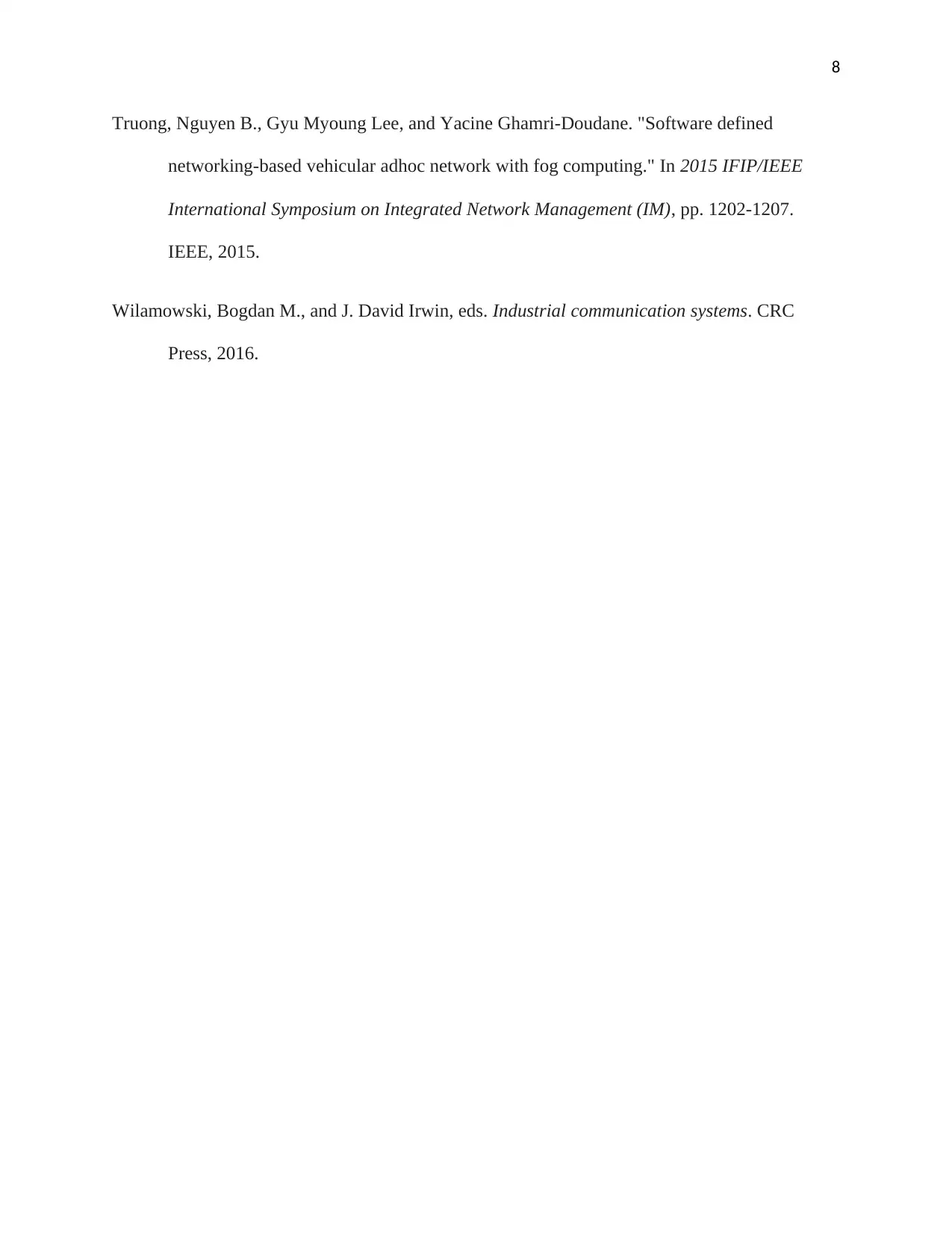
8
Truong, Nguyen B., Gyu Myoung Lee, and Yacine Ghamri-Doudane. "Software defined
networking-based vehicular adhoc network with fog computing." In 2015 IFIP/IEEE
International Symposium on Integrated Network Management (IM), pp. 1202-1207.
IEEE, 2015.
Wilamowski, Bogdan M., and J. David Irwin, eds. Industrial communication systems. CRC
Press, 2016.
Truong, Nguyen B., Gyu Myoung Lee, and Yacine Ghamri-Doudane. "Software defined
networking-based vehicular adhoc network with fog computing." In 2015 IFIP/IEEE
International Symposium on Integrated Network Management (IM), pp. 1202-1207.
IEEE, 2015.
Wilamowski, Bogdan M., and J. David Irwin, eds. Industrial communication systems. CRC
Press, 2016.
⊘ This is a preview!⊘
Do you want full access?
Subscribe today to unlock all pages.

Trusted by 1+ million students worldwide
1 out of 9
Related Documents
Your All-in-One AI-Powered Toolkit for Academic Success.
+13062052269
info@desklib.com
Available 24*7 on WhatsApp / Email
![[object Object]](/_next/static/media/star-bottom.7253800d.svg)
Unlock your academic potential
© 2024 | Zucol Services PVT LTD | All rights reserved.





